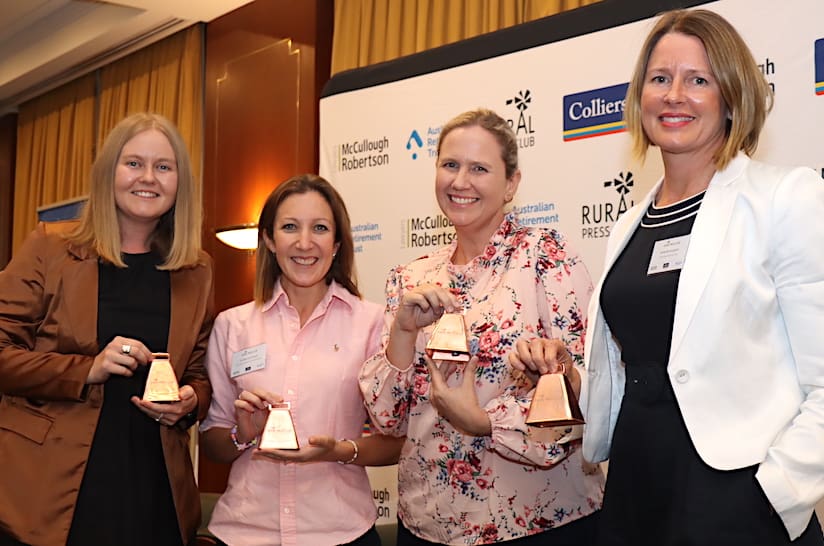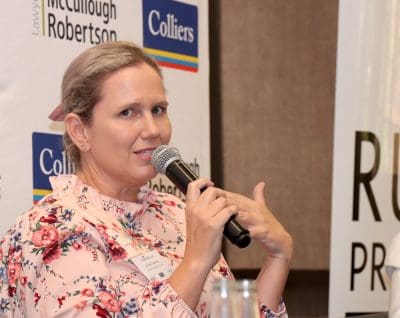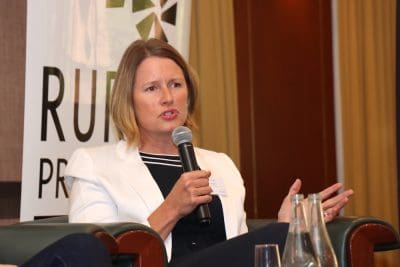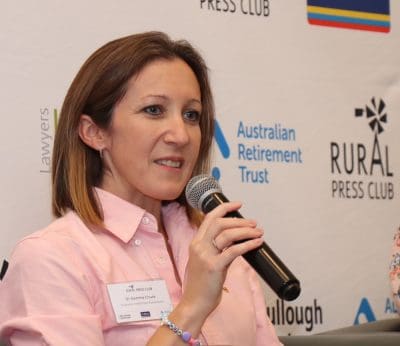
Rural Press Club of Queensland panel members for last week’s International Rural Women’s Day lunch were Lucy Kinbacher (moderator), Gemma Chuck, Tess Salmond and Amanda Roughan.
KEEPING rural veterinary clinics open is no easy task, as three rural veterinary experts highlighted to a Rural Press Club of Queensland lunch on International Rural Women’s Day last week.
Rural vet practices are essential for local communities, for animal health and welfare, for regional disease surveillance and control and for herd health and productivity across Australia’s $20 billion plus beef industry.
But they are also very challenging to keep operating, as Drs Gemma Chuck from the Australian Veterinary Association, Tess Salmond from the Clermont Veterinary Clinic and Amanda Roughan from South East Country Vets at Toogoolawah explained to a panel moderated by RPCQ committee member and Queensland Country Life editor Lucy Kinbacher.
Long and unpredictable hours, emotionally draining work, big distances to get from one job to the next and a lack of local childcare services were just some of the many challenges rural vets can face.
But despite those issues, the event also underlined why being a rural vet “is the best job in the world”, and emerging signs that the future is bright for the crucial profession.
Here’s a snapshot of some of the key points discussed throughout the lunch:
Rural vet shortage is real
Working with animals can be mentally draining, as can be dealing with their owners, the event was told. Work hours for rural vets can be long, gruelling and unpredictable, making making vets vulnerable to burnout, particularly in practices with only a handful of vets working.
A 2021 Australian Veterinary Association survey identified poor mental health and poor workplace culture as key issues contributing to a shortage of rural veterinarians.
Seven-day weeks no longer sustainable
 Clermont based Dr Tess Salmond (left), who has worked as rural vet for 20 years and previously owned a six-vet practice, said young vets want and need support.
Clermont based Dr Tess Salmond (left), who has worked as rural vet for 20 years and previously owned a six-vet practice, said young vets want and need support.
“The era of the single vet doing 24 hours a day is gone,” she said. “There comes a point where you just cannot work 15 hours a day and still get up in the middle of the night for a cow caesarean, it is just unsustainable.”
Where not-so-long-ago it was expected young vets would work seven days a week, now one on-call weekend out of every four weekends was considered necessary to achieve an appropriate work-life balance.
“They are happy to do it, they are happy to have a go, but they’re very mindful of burnout and all these words that we didn’t know when we graduated,” Tess said.
“One in four means you need at least four vets in the practice, because you need to rotate.”
Vet bills reflect cost of keeping doors open
Anyone who has sent an animal to a vet would likely agree that vet bills seem exorbitant, but vet owners said fees being charged reflected the high costs of keeping a vet clinic open.
A clinic with six vets and associated staff had a wage bill well above one million dollars and at any one time was owed half a million in unpaid accounts.
“One million dollars a year is a lot of dying cows and dogs with broken legs falling off utes to pay.”
From her research Tess said a bricks-and-mortar clinic in the bush with about four vets today would require a minimum of $6000 in invoicing a day to keep the doors open.
“For every vet there’s three support staff, there is the local girl who is there getting paid to do her vet nursing, and then there is supporting the local community and charity work which is all unpaid work.
“A general figure for us to have a vet working, that vet needs to be income producing $400 an hour to keep the doors open.
“Yes it looks horrific when we send these bills out, but that is $6000 a day for a normal sized rural vet practice, that is the break-even point.
“It feels like a big amount, but everyone wants the best, everyone wants the ultrasound, x-rays are $80,000… it just goes up and up.
“At the end of the day whatever rural industry we’re in, we need to be making a profit and be sustainable otherwise we can’t exist.”
Childcare road block
Almost 80 percent of the rural veterinary workforce under 40 are female.
A lack of local childcare services can have a major impact on the ability of vets returning from maternity leave to re-enter the workforce.
 At Toogoolawah, Amanda Roughan said a lot of professional people had moved to the region since COVID which was contributing to the high demand for local childcare services.
At Toogoolawah, Amanda Roughan said a lot of professional people had moved to the region since COVID which was contributing to the high demand for local childcare services.
“We have even looked at providing a child-minding service for our staff,” she said.
“We had four staff with eight kids between them who couldn’t find daycare.
“We really looked hard at trying to establish a child minding service as part of our business.
“But the red tape and the barriers, and the fact that they couldn’t receive a childcare subsidy with that, it was just too much for our business to take the leap and venture into, that is a whole different service sector.”
They have provided a space for children of staff to do homework after school as a measure to ease the childcare burden for staff.
Wellbeing consultants
The Roughans have also introduced a nine-day fortnight roster, ensuring each of their vets receives a day off for rest and recovery every two weeks, over above weekends and other leave entitlements.
The Toogoolawah-based clinic has made a priority of developing a positive workplace culture to attract and retain staff amidst the ongoing rural vet shortage. This included having clear values, business systems, protocols and boundaries, and ensuring vets have a safe and comfortable environment to raise any concerns they have.
“We also foster self-care and well-being in the workplace, and we have had a well-being consultant come into our team to look at what does self-care actually look like and what are the pillars of welfare,” Amanda said.
Huge costs vet students must bear
One challenge for rural vet students highlighted in the forum was the considerable costs they bear to undertake practical work placements as part of their veterinary degrees.
 AVA director and veterinary educator Dr Gemma Chuck said vet science students are required to Veterinary science 52 weeks of compulsory placement during their course.
AVA director and veterinary educator Dr Gemma Chuck said vet science students are required to Veterinary science 52 weeks of compulsory placement during their course.
“That is often undertaken during holiday time, and obviously in their placement they can’t also have a normal job during that time to earn money.
“Those placements are often self funded, and they often have to pay accommodation while they’re there, and also continue to pay rentals to keep their term time accommodation at the same time
Amanda Roughan said one graduate estimated that she had required about $20,000 to cash flow her work placements.
Earlier this year, the Federal Government announced that from July 2025, university students studying teaching, nursing and social work will be eligible to receive a new means tested payment of $319.50 a week during their work placements.
Yet veterinary science students will not be include in the same scheme.
Gemma Chuck said vets are essential health workers and should be included.
The AVA has been advocating “pretty hard” at State and Federal level for change to this rule, Gemma said, and in August appeared before a Senate Committee investigating the student support schemes to lobby for the inclusion of vet students in the program.
Getting vets into bush areas early is crucial
Gemma Chuck said it has been demonstrated that if students don’t gain experience in regional areas during their undergraduate years, the likelihood of them moving into regional areas after graduation was really small.
It was very important to get rural exposure for them while they were studying, she said.
“If we can’t get them there to get the exposure, we’re very unlikely to get them to live there afterwards.”
Keeping rural vets in town should be a community sport
Encouraging local community residents to offer accommodation to student vets to help during their work placements was another strategy vet clinics have used to help ease the burden.
Dr Tess Salmond put a post on social media encouraging locals to “Adopt a Vet” and said the response had been fantastic.
“I put a shout out to the community, and the community was fabulous, we now have a community that will house our vet students,” she said.
“These vets are keen, they are hungry, they want to contribute, but we have to look after them and they are not going to put up with the conditions that we did.”
“If we don’t invest in these young vets and show them a good time, and show them everything rural Australia has to offer which is so amazing – we have the best beef in the world – we need to keep these vets in these areas.”
A biosecurity ‘reserve army’
Keeping vets in rural areas was also crucial to maintain Australia’s biosecurity defence.
“The Government is relying on having these strong regional practices,” Tess Salmond said.
“We’re like the reserve army that is unpaid, we are ready.”
When vets visited properties they were also keep an eye on other disease and animal health issues.
However the recent deregulation of pregnancy testing in Queensland, which means lay people with training are now authorised to perform preg testing services in the state, had changed that dynamic.
“Everytime a farm decides to do their own preg testing, which is fine – cattle preg testing has been deregulated, and that is fine, because you don’t need a veterinary degree to say if it is pregnant – but it was a reason to get the vets on farm, it was a reason to have extra vets,” Tess said.
The deregulation had meant their local vet clinic had lost about $400,000 a year in income.
“The future is pretty bright”
Despite the obvious challenges, there are positive signs, Gemma Chuck said.
“The future is pretty bright about getting those young vets into rural areas,” she said.
“We’ve (AVA) recently just finished doing our member value feedback survey
 “Hot off the press, we surveyed a heap of students in that survey as well, ranging from first year to final year, and 60 percent of them responded that after graduation they want to work in a regional or rural practice.
“Hot off the press, we surveyed a heap of students in that survey as well, ranging from first year to final year, and 60 percent of them responded that after graduation they want to work in a regional or rural practice.
“So I think that is a really positive story, they want to come, they want to get here, we have just got to get them here and then once they’re here we’ve got to keep them.”
Tess Salmond said that being a rural vet was “honestly the best job in the world”.
“You get an opportunity to be there for these people in their darkest hour. It is such a privilege as a vet to get to serve and make connections and be there.
“And then there’s the adventure. Being a vet you get that excitement of being in a stock camp up in the Gulf and you’re there to preg testing, there is just that sense of fun and adventure.
“There is never a dull moment.
“It has fulfilled me professionally
“We get a chance to serve but a chance to set ourselves up financially, the veterinary profession has paid me back in spades.
“I am just so passionate about our young vets, they’re all told they’re going to burn out, they’re going to earn hardly any money, but the future is bright and these students, they’re outstanding coming through.
“It is a profession that just gives so much, that opportunity to care, that opportunity to serve and be rewarded financially for it.”
